Attached files
| file | filename |
|---|---|
| 8-K - 8-K - ACI WORLDWIDE, INC. | aciw-20201105.htm |
| EX-99.1 - EX-99.1 - ACI WORLDWIDE, INC. | aciw-20201105ex991.htm |
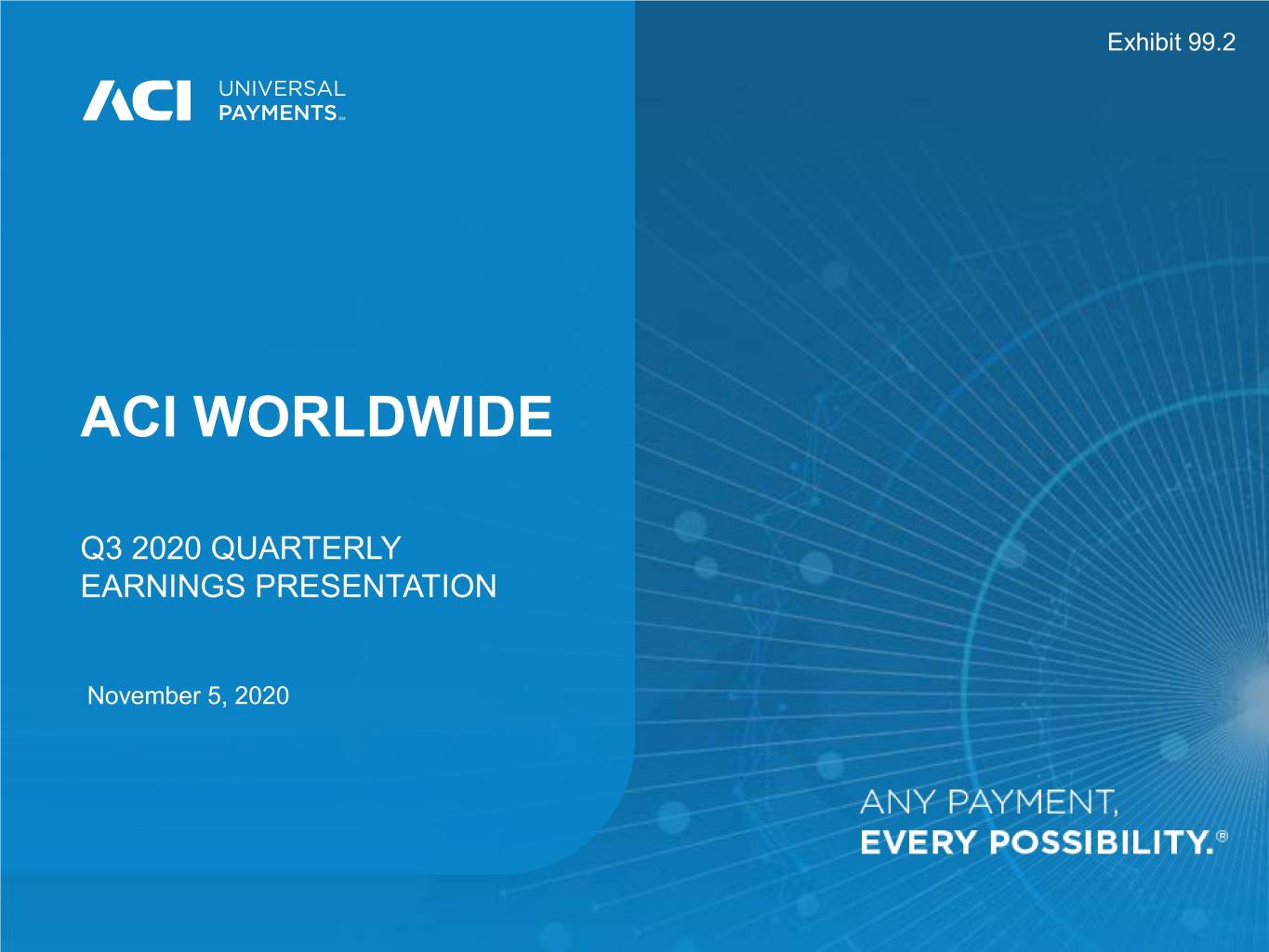
Exhibit 99.2 ACI WORLDWIDE Q3 2020 QUARTERLY EARNINGS PRESENTATION November 5, 2020
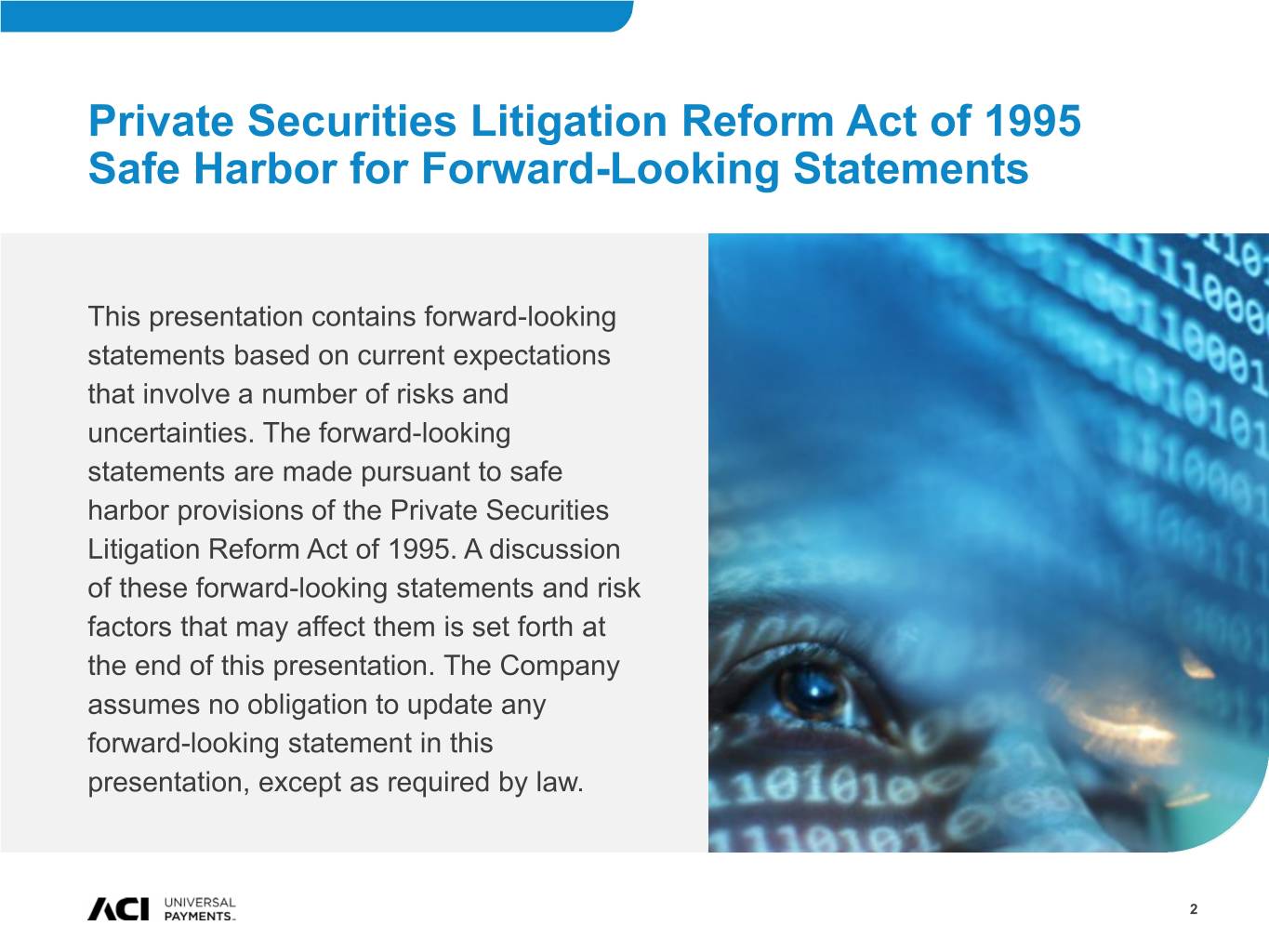
Private Securities Litigation Reform Act of 1995 Safe Harbor for Forward-Looking Statements This presentation contains forward-looking statements based on current expectations that involve a number of risks and uncertainties. The forward-looking statements are made pursuant to safe harbor provisions of the Private Securities Litigation Reform Act of 1995. A discussion of these forward-looking statements and risk factors that may affect them is set forth at the end of this presentation. The Company assumes no obligation to update any forward-looking statement in this presentation, except as required by law.
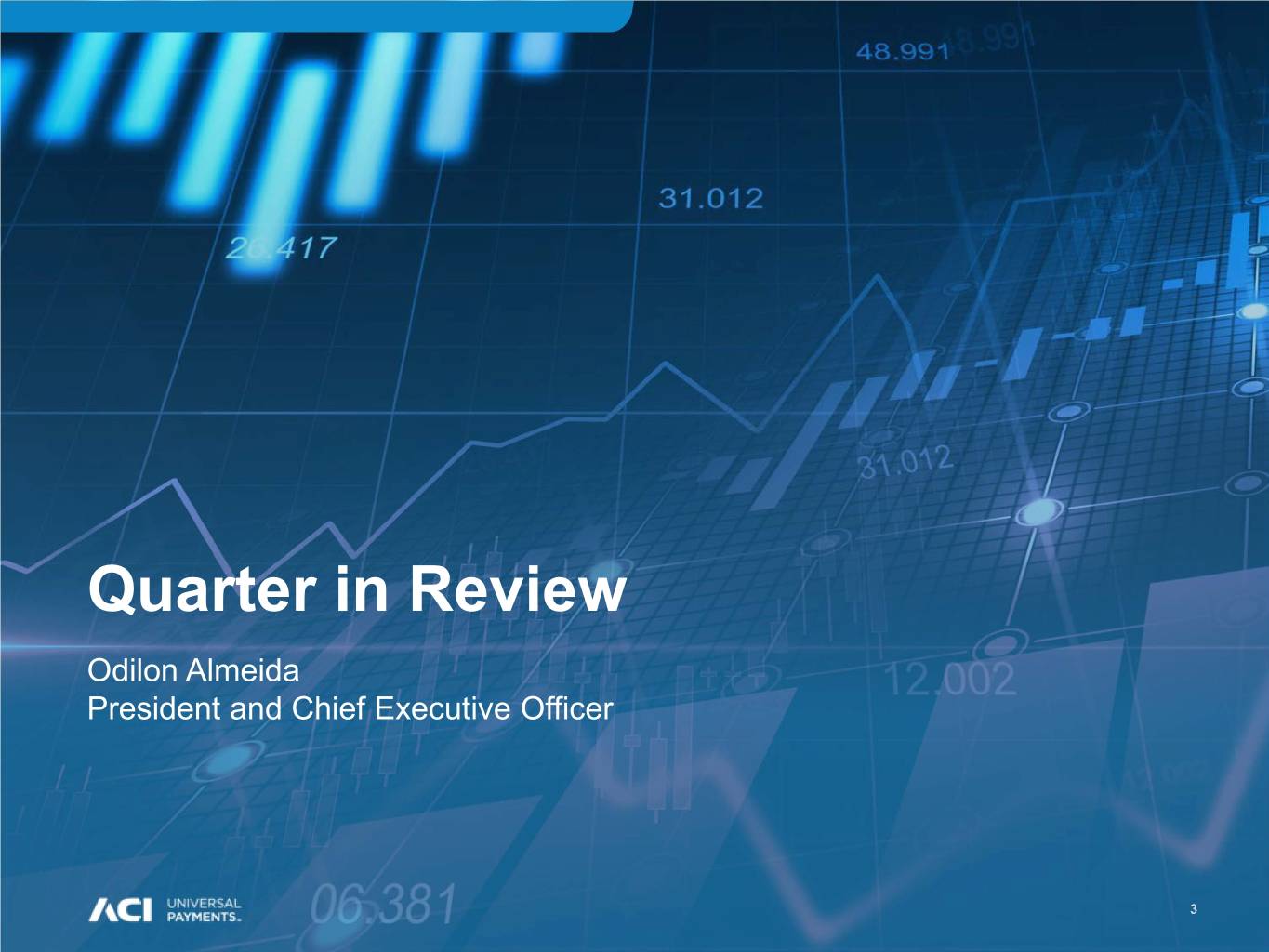
Quarter in Review Odilon Almeida President and Chief Executive Officer
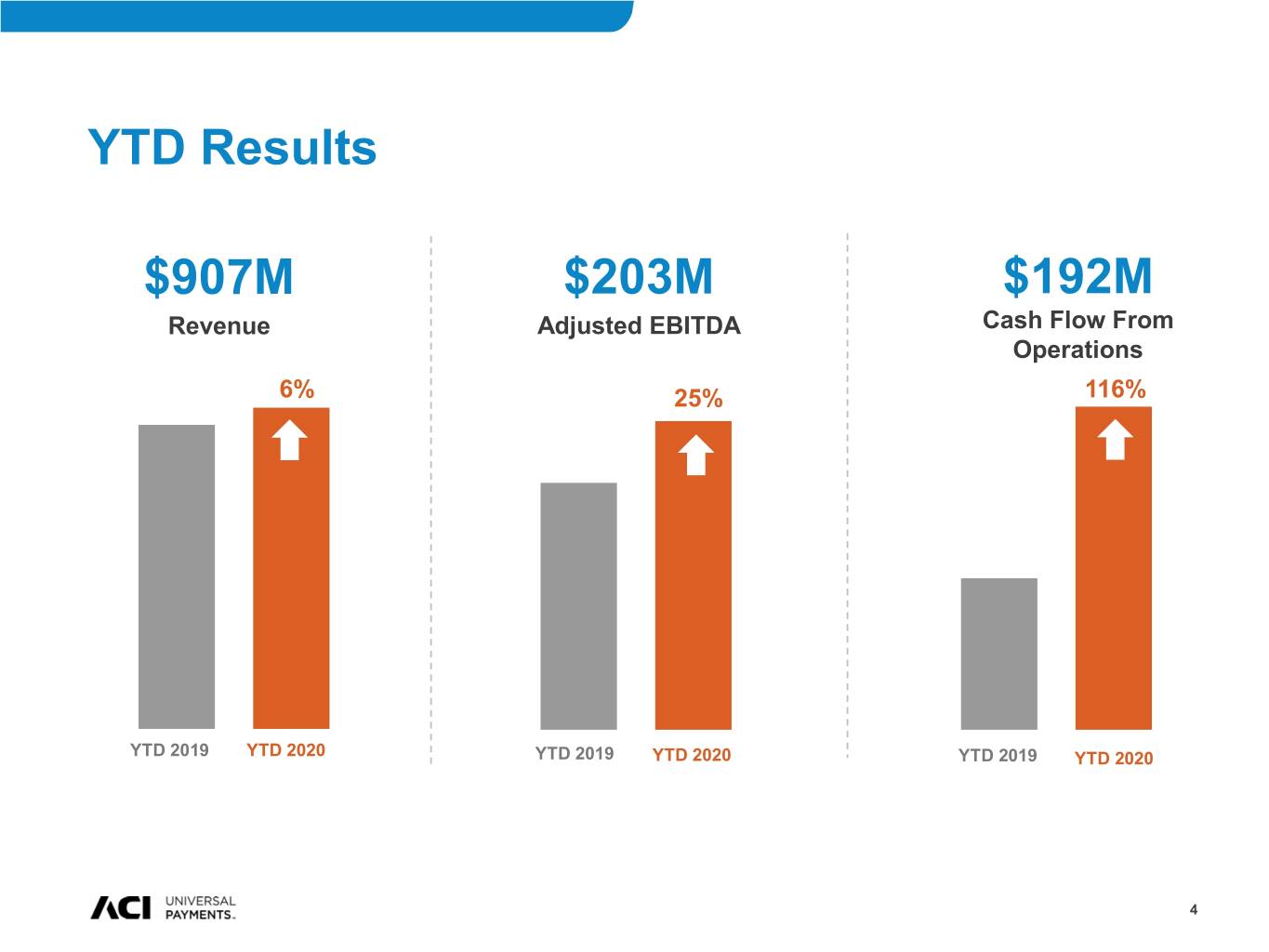
YTD Results $907M $203M $192M Revenue Adjusted EBITDA Cash Flow From Operations 6% 25% 116% +158% YTD 2019 YTD 2020 YTD 2019 YTD 2020 YTD 2019 YTD 2020
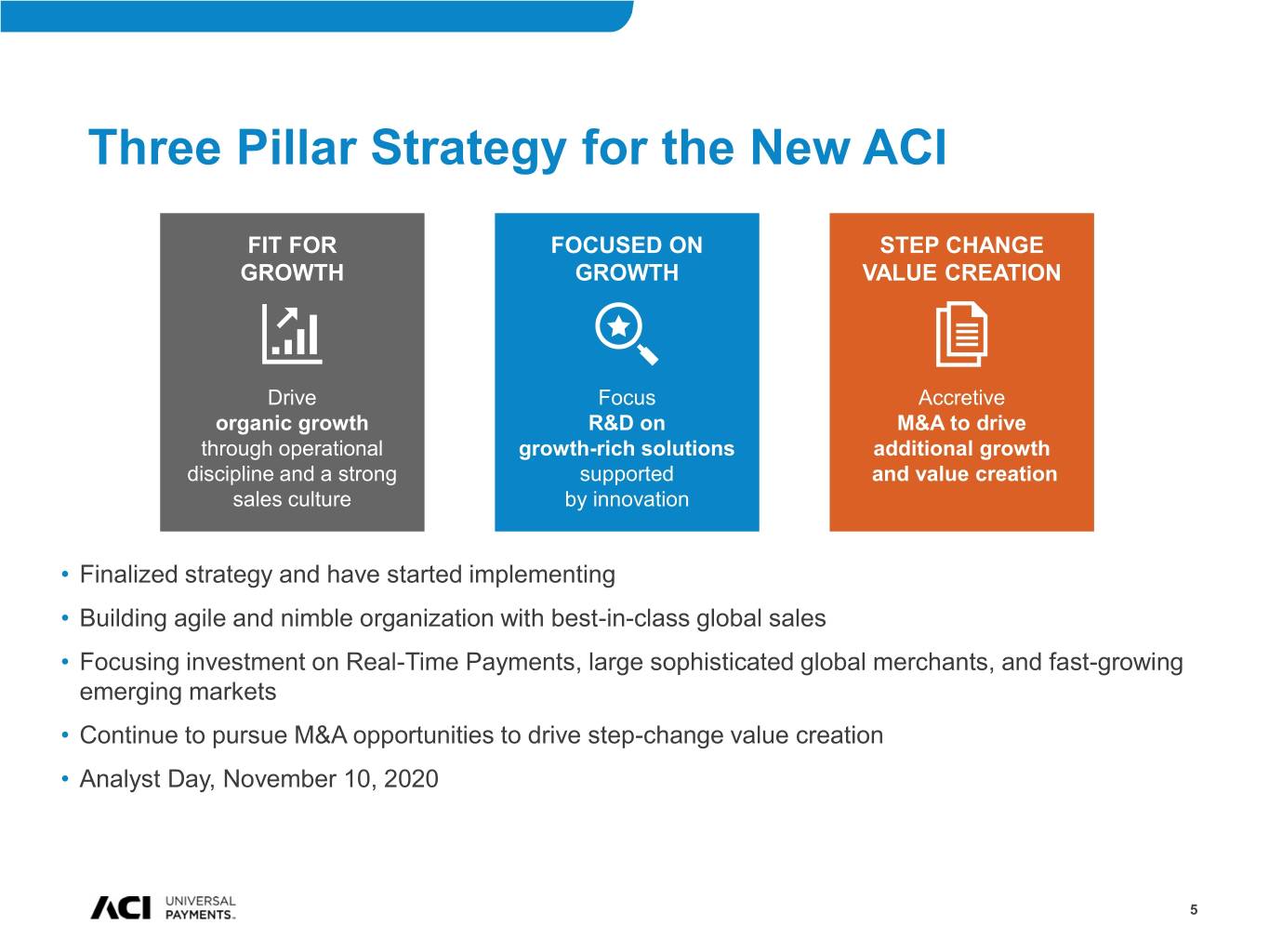
Three Pillar Strategy for the New ACI FIT FOR FOCUSED ON STEP CHANGE GROWTH GROWTH VALUE CREATION Drive Focus Accretive organic growth R&D on M&A to drive through operational growth-rich solutions additional growth discipline and a strong supported and value creation sales culture by innovation • Finalized strategy and have started implementing • Building agile and nimble organization with best-in-class global sales • Focusing investment on Real-Time Payments, large sophisticated global merchants, and fast-growing emerging markets • Continue to pursue M&A opportunities to drive step-change value creation • Analyst Day, November 10, 2020
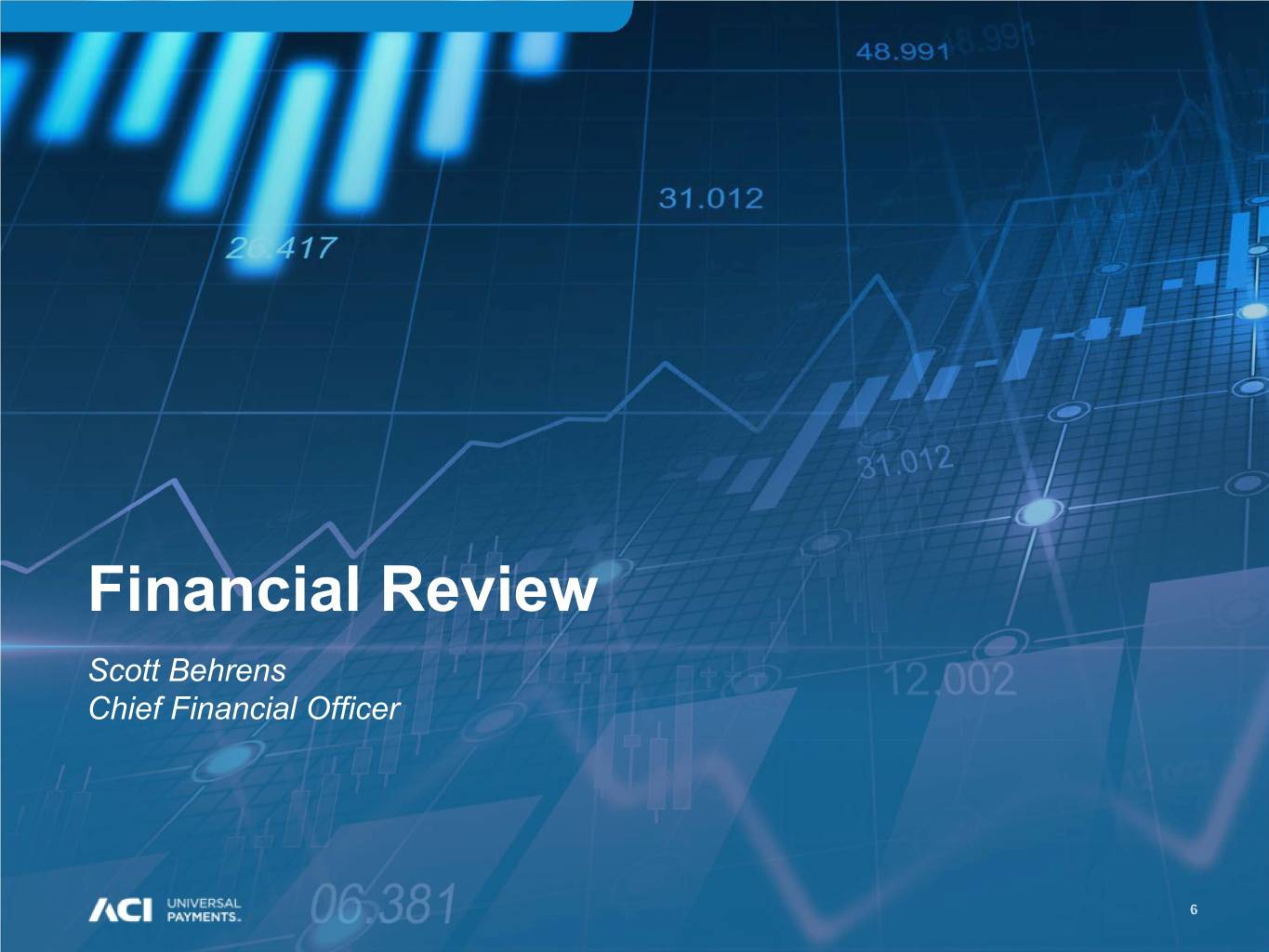
Financial Review Scott Behrens Chief Financial Officer
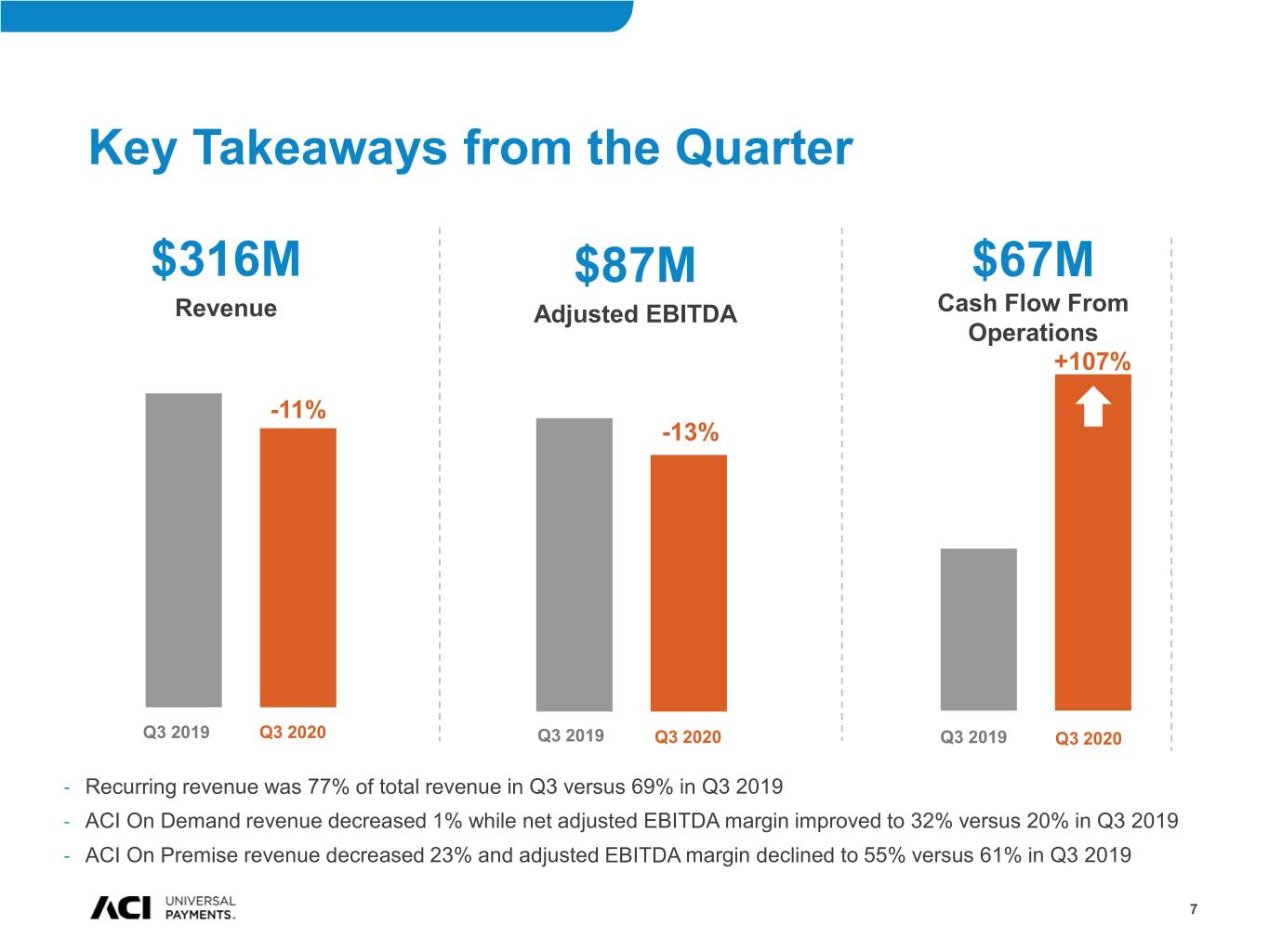
Key Takeaways from the Quarter $316M $87M $67M Revenue Adjusted EBITDA Cash Flow From Operations +107% -11% -13% Q3 2019 Q3 2020 Q3 2019 Q3 2020 Q3 2019 Q3 2020 - Recurring revenue was 77% of total revenue in Q3 versus 69% in Q3 2019 - ACI On Demand revenue decreased 1% while net adjusted EBITDA margin improved to 32% versus 20% in Q3 2019 - ACI On Premise revenue decreased 23% and adjusted EBITDA margin declined to 55% versus 61% in Q3 2019
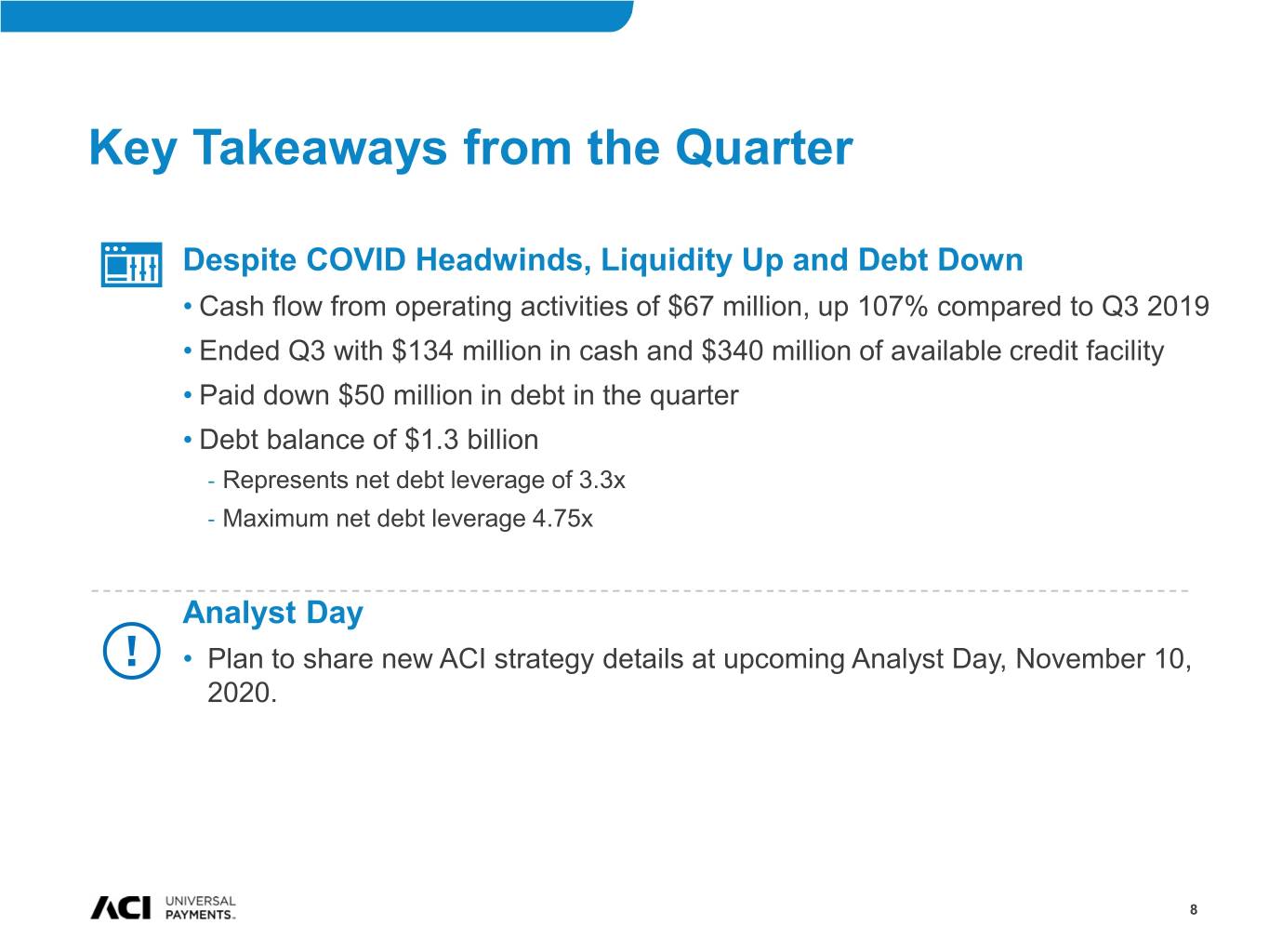
Key Takeaways from the Quarter Despite COVID Headwinds, Liquidity Up and Debt Down • Cash flow from operating activities of $67 million, up 107% compared to Q3 2019 • Ended Q3 with $134 million in cash and $340 million of available credit facility • Paid down $50 million in debt in the quarter • Debt balance of $1.3 billion - Represents net debt leverage of 3.3x - Maximum net debt leverage 4.75x Analyst Day • Plan to share new ACI strategy details at upcoming Analyst Day, November 10, 2020.

Appendix 9
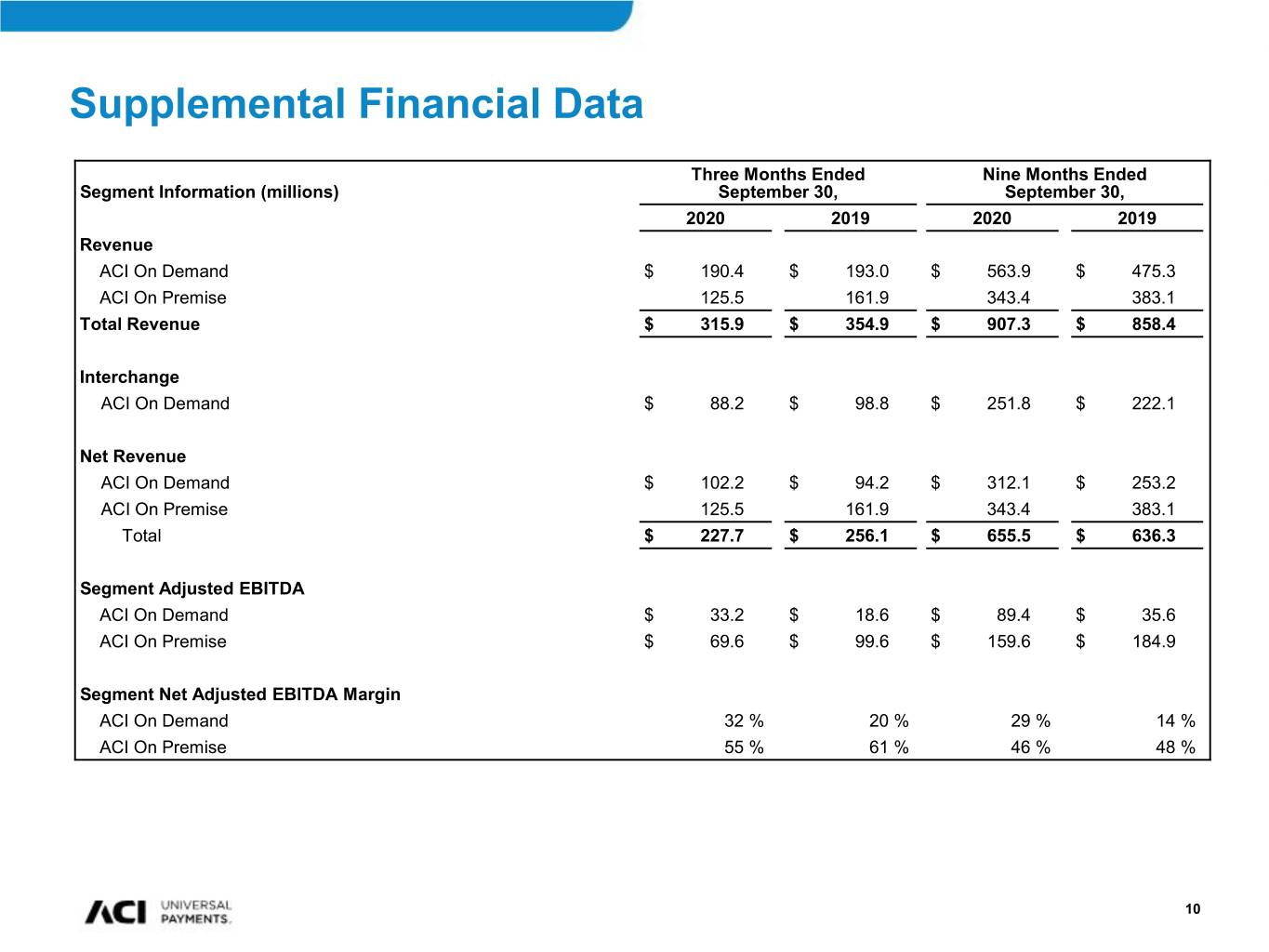
Supplemental Financial Data Three Months Ended Nine Months Ended Segment Information (millions) September 30, September 30, 2020 2019 2020 2019 Revenue ACI On Demand $ 190.4 $ 193.0 $ 563.9 $ 475.3 ACI On Premise 125.5 161.9 343.4 383.1 Total Revenue $ 315.9 $ 354.9 $ 907.3 $ 858.4 Interchange ACI On Demand $ 88.2 $ 98.8 $ 251.8 $ 222.1 Net Revenue ACI On Demand $ 102.2 $ 94.2 $ 312.1 $ 253.2 ACI On Premise 125.5 161.9 343.4 383.1 Total $ 227.7 $ 256.1 $ 655.5 $ 636.3 Segment Adjusted EBITDA ACI On Demand $ 33.2 $ 18.6 $ 89.4 $ 35.6 ACI On Premise $ 69.6 $ 99.6 $ 159.6 $ 184.9 Segment Net Adjusted EBITDA Margin ACI On Demand 32 % 20 % 29 % 14 % ACI On Premise 55 % 61 % 46 % 48 % 10
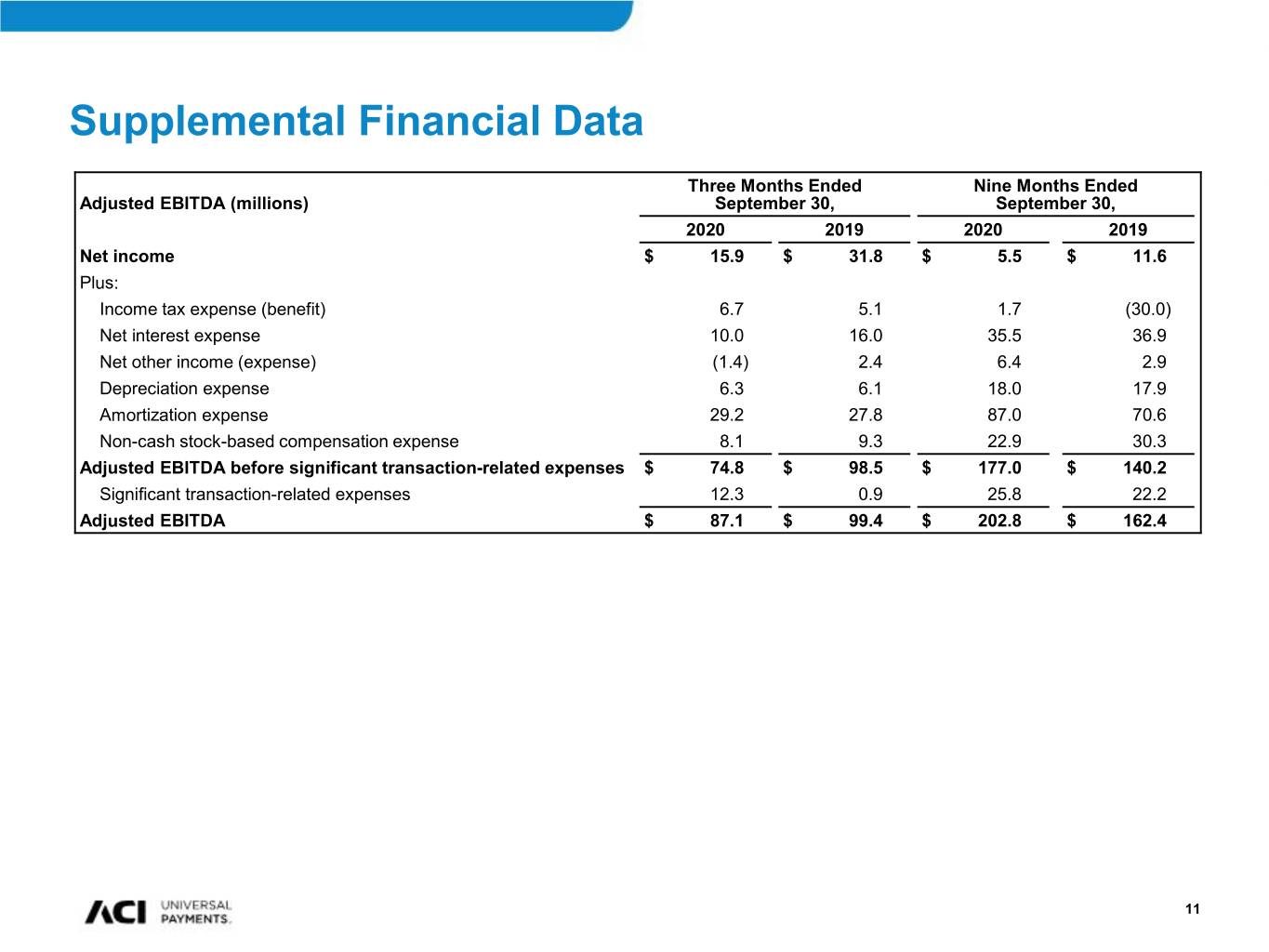
Supplemental Financial Data Three Months Ended Nine Months Ended Adjusted EBITDA (millions) September 30, September 30, 2020 2019 2020 2019 Net income $ 15.9 $ 31.8 $ 5.5 $ 11.6 Plus: Income tax expense (benefit) 6.7 5.1 1.7 (30.0) Net interest expense 10.0 16.0 35.5 36.9 Net other income (expense) (1.4) 2.4 6.4 2.9 Depreciation expense 6.3 6.1 18.0 17.9 Amortization expense 29.2 27.8 87.0 70.6 Non-cash stock-based compensation expense 8.1 9.3 22.9 30.3 Adjusted EBITDA before significant transaction-related expenses $ 74.8 $ 98.5 $ 177.0 $ 140.2 Significant transaction-related expenses 12.3 0.9 25.8 22.2 Adjusted EBITDA $ 87.1 $ 99.4 $ 202.8 $ 162.4 11
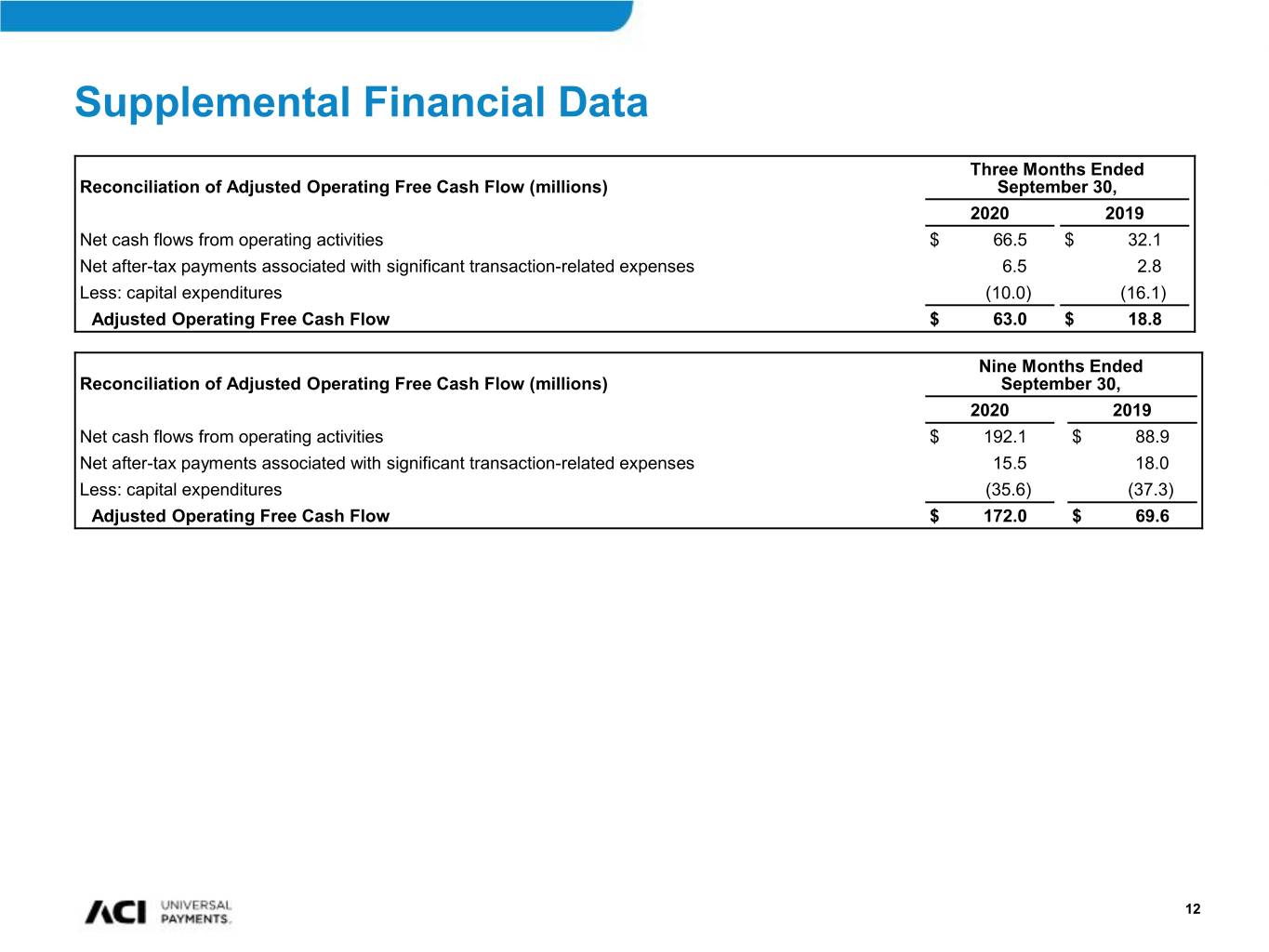
Supplemental Financial Data Three Months Ended Reconciliation of Adjusted Operating Free Cash Flow (millions) September 30, 2020 2019 Net cash flows from operating activities $ 66.5 $ 32.1 Net after-tax payments associated with significant transaction-related expenses 6.5 2.8 Less: capital expenditures (10.0) (16.1) Adjusted Operating Free Cash Flow $ 63.0 $ 18.8 Nine Months Ended Reconciliation of Adjusted Operating Free Cash Flow (millions) September 30, 2020 2019 Net cash flows from operating activities $ 192.1 $ 88.9 Net after-tax payments associated with significant transaction-related expenses 15.5 18.0 Less: capital expenditures (35.6) (37.3) Adjusted Operating Free Cash Flow $ 172.0 $ 69.6 12
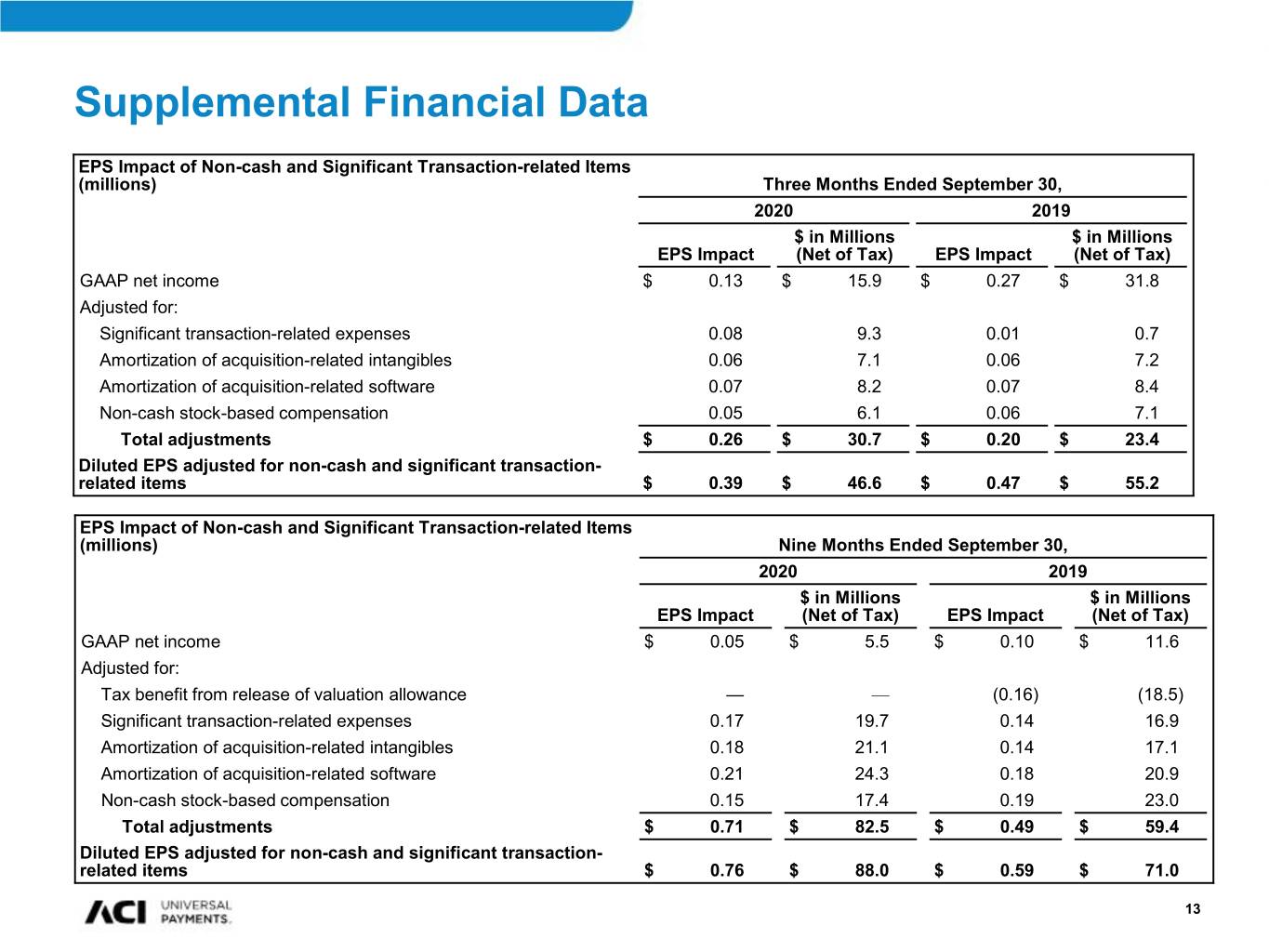
Supplemental Financial Data EPS Impact of Non-cash and Significant Transaction-related Items (millions) Three Months Ended September 30, 2020 2019 $ in Millions $ in Millions EPS Impact (Net of Tax) EPS Impact (Net of Tax) GAAP net income $ 0.13 $ 15.9 $ 0.27 $ 31.8 Adjusted for: Significant transaction-related expenses 0.08 9.3 0.01 0.7 Amortization of acquisition-related intangibles 0.06 7.1 0.06 7.2 Amortization of acquisition-related software 0.07 8.2 0.07 8.4 Non-cash stock-based compensation 0.05 6.1 0.06 7.1 Total adjustments $ 0.26 $ 30.7 $ 0.20 $ 23.4 Diluted EPS adjusted for non-cash and significant transaction- related items $ 0.39 $ 46.6 $ 0.47 $ 55.2 EPS Impact of Non-cash and Significant Transaction-related Items (millions) Nine Months Ended September 30, 2020 2019 $ in Millions $ in Millions EPS Impact (Net of Tax) EPS Impact (Net of Tax) GAAP net income $ 0.05 $ 5.5 $ 0.10 $ 11.6 Adjusted for: Tax benefit from release of valuation allowance — — (0.16) (18.5) Significant transaction-related expenses 0.17 19.7 0.14 16.9 Amortization of acquisition-related intangibles 0.18 21.1 0.14 17.1 Amortization of acquisition-related software 0.21 24.3 0.18 20.9 Non-cash stock-based compensation 0.15 17.4 0.19 23.0 Total adjustments $ 0.71 $ 82.5 $ 0.49 $ 59.4 Diluted EPS adjusted for non-cash and significant transaction- related items $ 0.76 $ 88.0 $ 0.59 $ 71.0 13
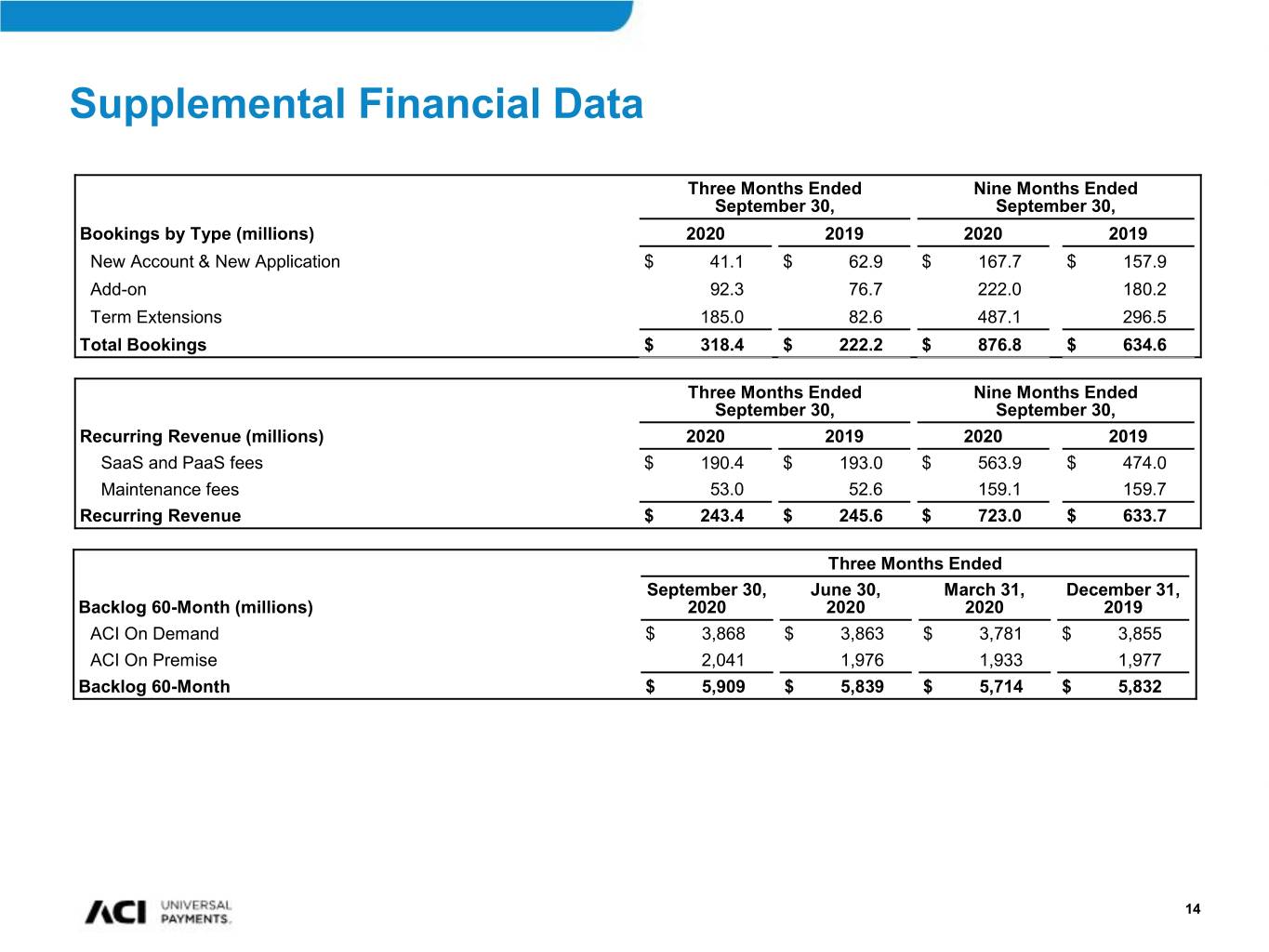
Supplemental Financial Data Three Months Ended Nine Months Ended September 30, September 30, Bookings by Type (millions) 2020 2019 2020 2019 New Account & New Application $ 41.1 $ 62.9 $ 167.7 $ 157.9 Add-on 92.3 76.7 222.0 180.2 Term Extensions 185.0 82.6 487.1 296.5 Total Bookings $ 318.4 $ 222.2 $ 876.8 $ 634.6 Three Months Ended Nine Months Ended September 30, September 30, Recurring Revenue (millions) 2020 2019 2020 2019 SaaS and PaaS fees $ 190.4 $ 193.0 $ 563.9 $ 474.0 Maintenance fees 53.0 52.6 159.1 159.7 Recurring Revenue $ 243.4 $ 245.6 $ 723.0 $ 633.7 Three Months Ended September 30, June 30, March 31, December 31, Backlog 60-Month (millions) 2020 2020 2020 2019 ACI On Demand $ 3,868 $ 3,863 $ 3,781 $ 3,855 ACI On Premise 2,041 1,976 1,933 1,977 Backlog 60-Month $ 5,909 $ 5,839 $ 5,714 $ 5,832 14
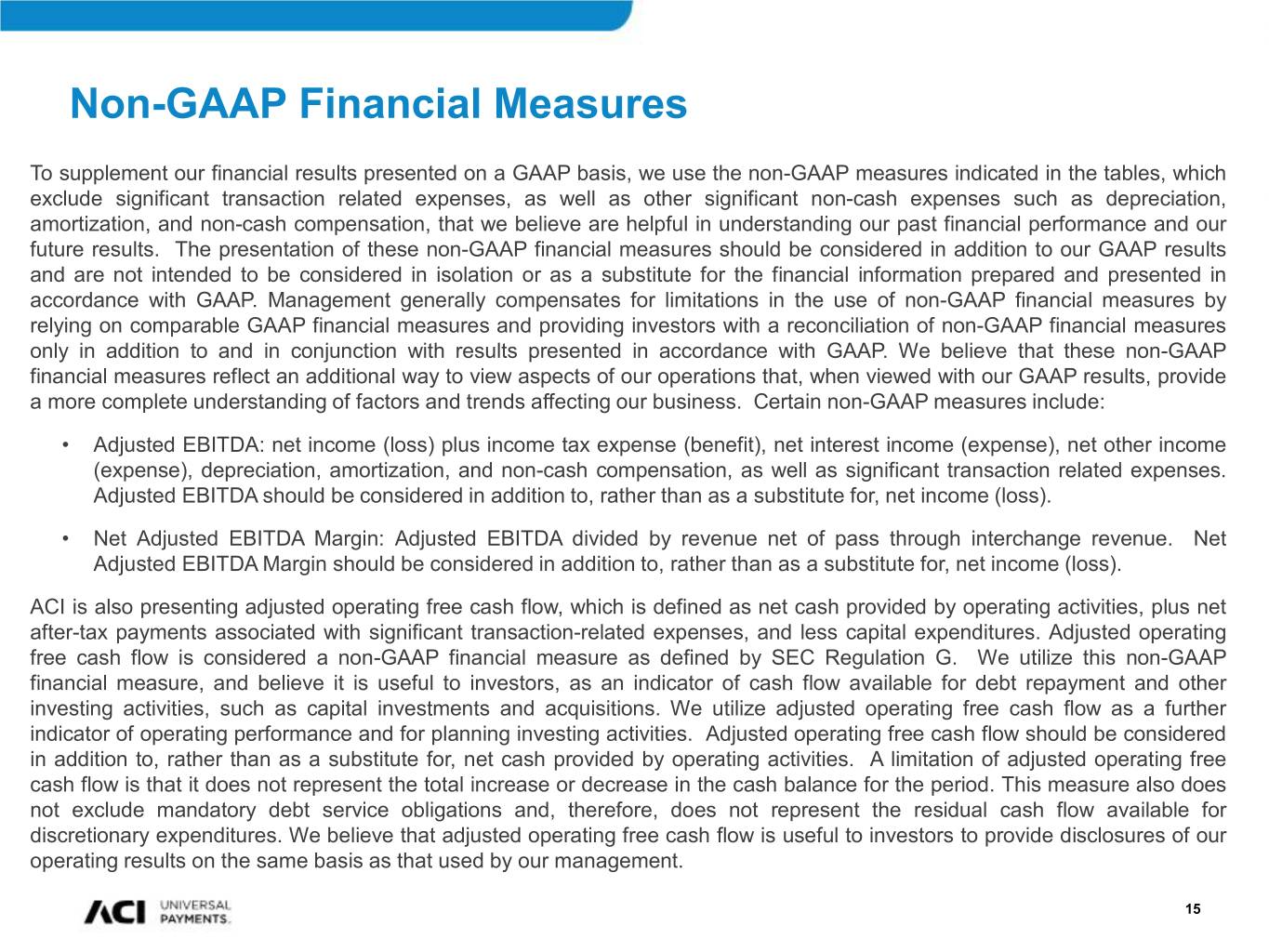
Non-GAAP Financial Measures To supplement our financial results presented on a GAAP basis, we use the non-GAAP measures indicated in the tables, which exclude significant transaction related expenses, as well as other significant non-cash expenses such as depreciation, amortization, and non-cash compensation, that we believe are helpful in understanding our past financial performance and our future results. The presentation of these non-GAAP financial measures should be considered in addition to our GAAP results and are not intended to be considered in isolation or as a substitute for the financial information prepared and presented in accordance with GAAP. Management generally compensates for limitations in the use of non-GAAP financial measures by relying on comparable GAAP financial measures and providing investors with a reconciliation of non-GAAP financial measures only in addition to and in conjunction with results presented in accordance with GAAP. We believe that these non-GAAP financial measures reflect an additional way to view aspects of our operations that, when viewed with our GAAP results, provide a more complete understanding of factors and trends affecting our business. Certain non-GAAP measures include: • Adjusted EBITDA: net income (loss) plus income tax expense (benefit), net interest income (expense), net other income (expense), depreciation, amortization, and non-cash compensation, as well as significant transaction related expenses. Adjusted EBITDA should be considered in addition to, rather than as a substitute for, net income (loss). • Net Adjusted EBITDA Margin: Adjusted EBITDA divided by revenue net of pass through interchange revenue. Net Adjusted EBITDA Margin should be considered in addition to, rather than as a substitute for, net income (loss). ACI is also presenting adjusted operating free cash flow, which is defined as net cash provided by operating activities, plus net after-tax payments associated with significant transaction-related expenses, and less capital expenditures. Adjusted operating free cash flow is considered a non-GAAP financial measure as defined by SEC Regulation G. We utilize this non-GAAP financial measure, and believe it is useful to investors, as an indicator of cash flow available for debt repayment and other investing activities, such as capital investments and acquisitions. We utilize adjusted operating free cash flow as a further indicator of operating performance and for planning investing activities. Adjusted operating free cash flow should be considered in addition to, rather than as a substitute for, net cash provided by operating activities. A limitation of adjusted operating free cash flow is that it does not represent the total increase or decrease in the cash balance for the period. This measure also does not exclude mandatory debt service obligations and, therefore, does not represent the residual cash flow available for discretionary expenditures. We believe that adjusted operating free cash flow is useful to investors to provide disclosures of our operating results on the same basis as that used by our management. 15
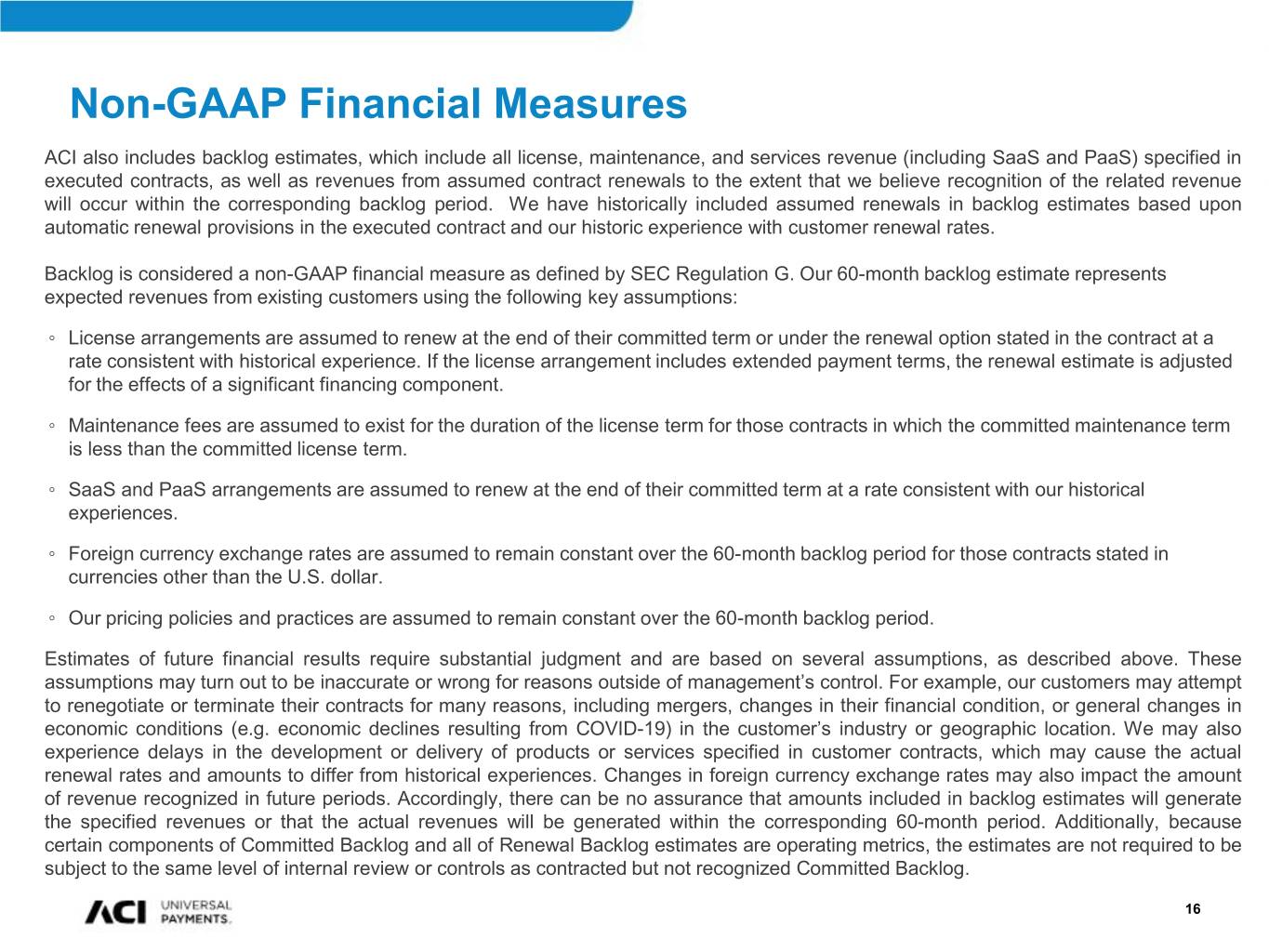
Non-GAAP Financial Measures ACI also includes backlog estimates, which include all license, maintenance, and services revenue (including SaaS and PaaS) specified in executed contracts, as well as revenues from assumed contract renewals to the extent that we believe recognition of the related revenue will occur within the corresponding backlog period. We have historically included assumed renewals in backlog estimates based upon automatic renewal provisions in the executed contract and our historic experience with customer renewal rates. Backlog is considered a non-GAAP financial measure as defined by SEC Regulation G. Our 60-month backlog estimate represents expected revenues from existing customers using the following key assumptions: ◦ License arrangements are assumed to renew at the end of their committed term or under the renewal option stated in the contract at a rate consistent with historical experience. If the license arrangement includes extended payment terms, the renewal estimate is adjusted for the effects of a significant financing component. ◦ Maintenance fees are assumed to exist for the duration of the license term for those contracts in which the committed maintenance term is less than the committed license term. ◦ SaaS and PaaS arrangements are assumed to renew at the end of their committed term at a rate consistent with our historical experiences. ◦ Foreign currency exchange rates are assumed to remain constant over the 60-month backlog period for those contracts stated in currencies other than the U.S. dollar. ◦ Our pricing policies and practices are assumed to remain constant over the 60-month backlog period. Estimates of future financial results require substantial judgment and are based on several assumptions, as described above. These assumptions may turn out to be inaccurate or wrong for reasons outside of management’s control. For example, our customers may attempt to renegotiate or terminate their contracts for many reasons, including mergers, changes in their financial condition, or general changes in economic conditions (e.g. economic declines resulting from COVID-19) in the customer’s industry or geographic location. We may also experience delays in the development or delivery of products or services specified in customer contracts, which may cause the actual renewal rates and amounts to differ from historical experiences. Changes in foreign currency exchange rates may also impact the amount of revenue recognized in future periods. Accordingly, there can be no assurance that amounts included in backlog estimates will generate the specified revenues or that the actual revenues will be generated within the corresponding 60-month period. Additionally, because certain components of Committed Backlog and all of Renewal Backlog estimates are operating metrics, the estimates are not required to be subject to the same level of internal review or controls as contracted but not recognized Committed Backlog. 16
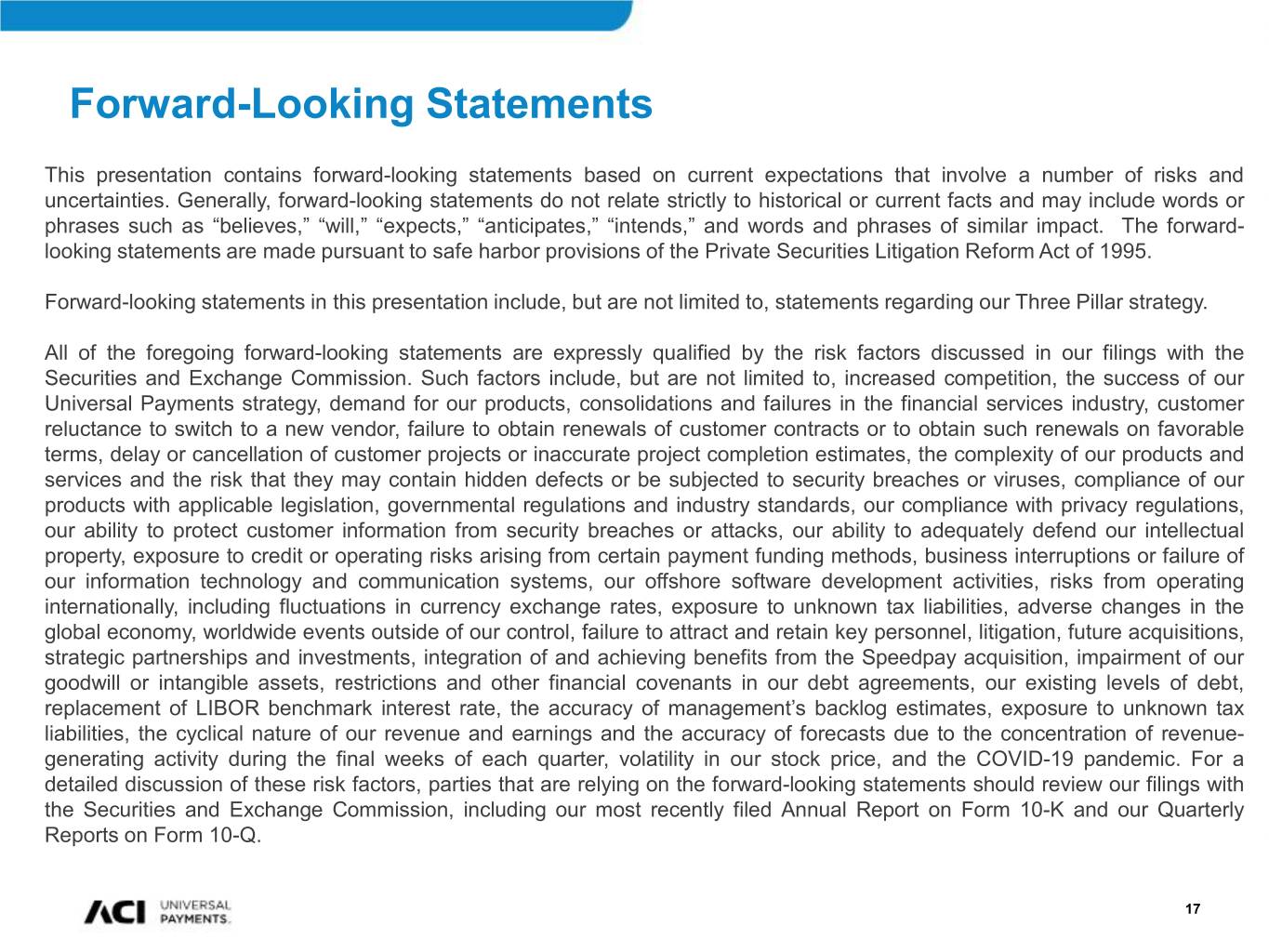
Forward-Looking Statements This presentation contains forward-looking statements based on current expectations that involve a number of risks and uncertainties. Generally, forward-looking statements do not relate strictly to historical or current facts and may include words or phrases such as “believes,” “will,” “expects,” “anticipates,” “intends,” and words and phrases of similar impact. The forward- looking statements are made pursuant to safe harbor provisions of the Private Securities Litigation Reform Act of 1995. Forward-looking statements in this presentation include, but are not limited to, statements regarding our Three Pillar strategy. All of the foregoing forward-looking statements are expressly qualified by the risk factors discussed in our filings with the Securities and Exchange Commission. Such factors include, but are not limited to, increased competition, the success of our Universal Payments strategy, demand for our products, consolidations and failures in the financial services industry, customer reluctance to switch to a new vendor, failure to obtain renewals of customer contracts or to obtain such renewals on favorable terms, delay or cancellation of customer projects or inaccurate project completion estimates, the complexity of our products and services and the risk that they may contain hidden defects or be subjected to security breaches or viruses, compliance of our products with applicable legislation, governmental regulations and industry standards, our compliance with privacy regulations, our ability to protect customer information from security breaches or attacks, our ability to adequately defend our intellectual property, exposure to credit or operating risks arising from certain payment funding methods, business interruptions or failure of our information technology and communication systems, our offshore software development activities, risks from operating internationally, including fluctuations in currency exchange rates, exposure to unknown tax liabilities, adverse changes in the global economy, worldwide events outside of our control, failure to attract and retain key personnel, litigation, future acquisitions, strategic partnerships and investments, integration of and achieving benefits from the Speedpay acquisition, impairment of our goodwill or intangible assets, restrictions and other financial covenants in our debt agreements, our existing levels of debt, replacement of LIBOR benchmark interest rate, the accuracy of management’s backlog estimates, exposure to unknown tax liabilities, the cyclical nature of our revenue and earnings and the accuracy of forecasts due to the concentration of revenue- generating activity during the final weeks of each quarter, volatility in our stock price, and the COVID-19 pandemic. For a detailed discussion of these risk factors, parties that are relying on the forward-looking statements should review our filings with the Securities and Exchange Commission, including our most recently filed Annual Report on Form 10-K and our Quarterly Reports on Form 10-Q. 17
